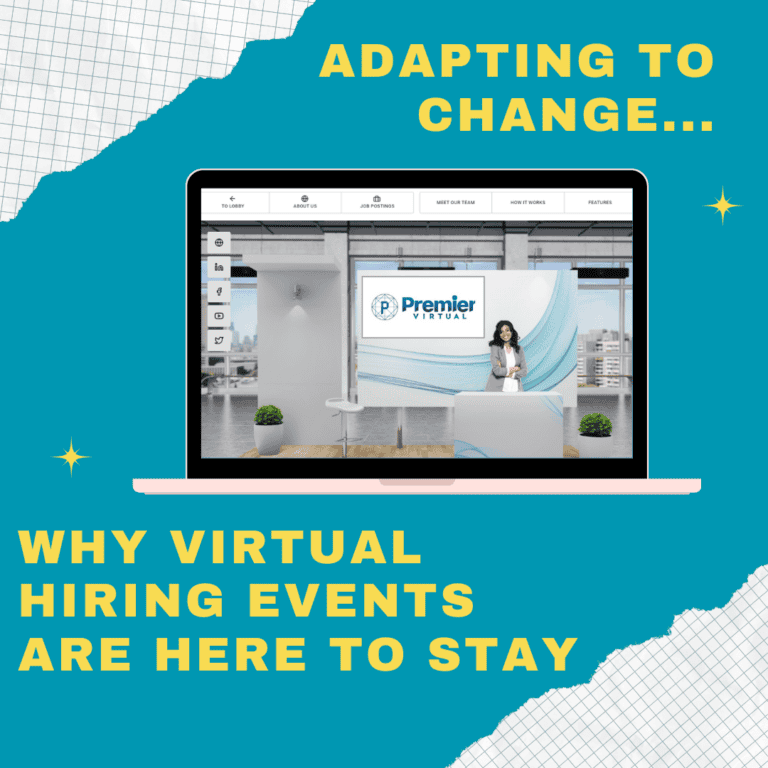Making the Most of Virtual Hiring Events: Insider Tips by Recruiters for Recruiters
Gary Chambers
on
July 29, 2024

Virtual hiring events have become a staple in the recruitment industry, particularly in the post-pandemic world. They offer numerous benefits, including cost savings, a wider talent pool, and convenience for both recruiters and candidates. However, to maximize these benefits, it’s essential to understand the intricacies of organizing and participating in virtual hiring events. In this blog post, we’ll delve into expert tips from seasoned recruiters to help you make the most of your virtual hiring events.
Understanding the Basics of Virtual Hiring Events
Before diving into the tips, it’s important to grasp what virtual hiring events are. These events are essentially online job fairs where employers and job seekers meet through a digital platform. They can include live video interviews, webinars, and virtual booths where candidates can interact with company representatives.
Preparing for the Event
Preparation is key to the success of any virtual hiring event. Here are some steps to ensure you’re ready:
Choose the Right Platform: Not all virtual event platforms are created equal. Look for one that offers features like video conferencing, chat functions, and easy integration with your ATS (Applicant Tracking System).
Set Clear Goals: What do you hope to achieve from the event? Whether it’s filling a specific number of positions or increasing brand awareness, having clear goals will guide your planning process.
Plan Your Schedule: Create a detailed schedule for the event, including time slots for interviews, presentations, and Q&A sessions. This will help keep things organized and ensure you make the most of the time available.
Promote the Event: Use social media, email campaigns, and your company’s website to promote the event. The more visibility it has, the better your chances of attracting top talent.
Crafting an Engaging Experience
An engaging experience is crucial to keep candidates interested and excited about your company. Here’s how you can create one:
Interactive Content: Incorporate interactive elements such as live Q&A sessions, polls, and breakout rooms. This not only keeps candidates engaged but also provides valuable insights into their preferences and concerns.
Virtual Booths: Set up virtual booths where candidates can learn more about your company, view job openings, and chat with recruiters. Make sure these booths are visually appealing and easy to navigate.
Pre-Event Workshops: Offer workshops or webinars before the main event to help candidates prepare. Topics can include resume writing, interview tips, and an overview of your company culture.
Engage Your Current Employees: Involve your current employees in the event. They can share their experiences, answer questions, and give candidates a glimpse into what it’s like to work at your company.
Conducting Effective Interviews
The interview process is a critical component of any hiring event. Here’s how to ensure yours are effective:
Structured Interviews: Use structured interviews to ensure consistency and fairness. Prepare a set of questions that align with the job requirements and company values.
Tech Check: Ensure that all participants have the necessary technology and that it works smoothly. Conduct a tech check before the event to troubleshoot any potential issues.
Active Listening: Pay close attention to candidates’ responses. This not only shows respect but also helps you gather more accurate information about their suitability for the role.
Provide Clear Instructions: Make sure candidates know what to expect during the interview. Provide clear instructions on how to join the virtual meeting, what the interview process will entail, and who they will be speaking with.
Follow-Up and Feedback
Following up after the event is just as important as the event itself. Here’s how to do it effectively:
Timely Communication: Follow up with candidates promptly. Whether they are moving forward in the process or not, timely communication shows respect and professionalism.
Constructive Feedback: Provide constructive feedback to candidates who were not selected. This helps them improve and leaves a positive impression of your company.
Data Analysis: Analyze the data from the event to identify what worked well and what could be improved. Look at metrics like the number of attendees, engagement levels, and the quality of candidates.
Continuous Improvement: Use the insights gained to continuously improve your virtual hiring events. This can help you attract better talent and streamline your recruitment process.
Leveraging Technology
Technology is at the heart of virtual hiring events. Here’s how to leverage it effectively:
AI and Automation: Use AI and automation tools to streamline tasks like candidate screening and interview scheduling. This can save time and reduce administrative burdens.
Virtual Reality (VR): Consider incorporating VR to provide candidates with a virtual tour of your office or a simulated work environment. This can give them a better sense of your company culture.
Data Analytics: Utilize data analytics to gain insights into candidate behavior and preferences. This can help you tailor your approach and improve the candidate experience.
Social Media Integration: Integrate social media into your event to increase engagement and reach. Use platforms like LinkedIn, Twitter, and Facebook to promote the event and interact with candidates.
Building a Strong Employer Brand
Your employer brand plays a crucial role in attracting top talent. Here’s how to build and showcase a strong employer brand during virtual hiring events:
Consistent Messaging: Ensure that your messaging is consistent across all channels. This includes your website, social media, and the virtual event platform.
Employee Testimonials: Share testimonials from current employees to give candidates an authentic view of your company culture.
Company Values: Highlight your company values and how they are embodied in the workplace. This helps candidates determine if they align with your company’s mission and values.
Visual Identity: Use consistent branding elements like logos, colors, and fonts to create a cohesive visual identity. This makes your company more recognizable and memorable.
Addressing Challenges
Virtual hiring events come with their own set of challenges. Here’s how to address them:
Technical Issues: Be prepared for technical issues and have a backup plan in place. This could include having IT support on standby or providing alternative contact methods.
Candidate Engagement: Keeping candidates engaged in a virtual setting can be challenging. Use interactive content and personalized communication to maintain their interest.
Screening Volume: Virtual events can attract a large number of candidates, making it difficult to screen them all effectively. Use AI and automation tools to streamline this process.
Maintaining Personal Connection: It can be harder to build a personal connection with candidates virtually. Make an effort to be personable and approachable, and encourage open communication.
Conclusion
Virtual hiring events offer a unique opportunity to connect with a wide range of candidates. By understanding the basics, preparing thoroughly, crafting an engaging experience, conducting effective interviews, and leveraging technology, you can make the most of these events. Additionally, building a strong employer brand and addressing challenges head-on will set you up for success. By following these insider tips from experienced recruiters, you can enhance your virtual hiring strategy and attract top talent to your organization.
Remember, the key to success is continuous improvement. Analyze your results, gather feedback, and make adjustments as needed. With the right approach, virtual hiring events can be a powerful tool in your recruitment arsenal.









